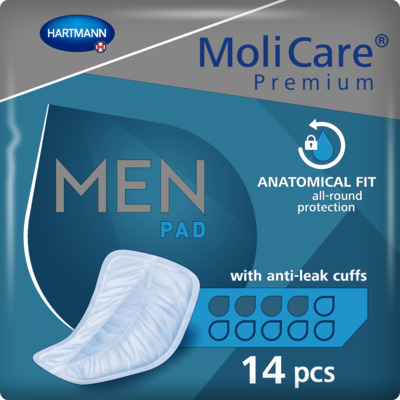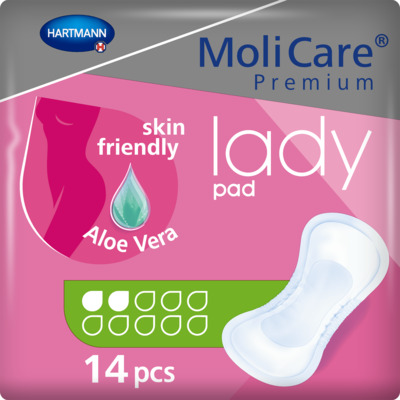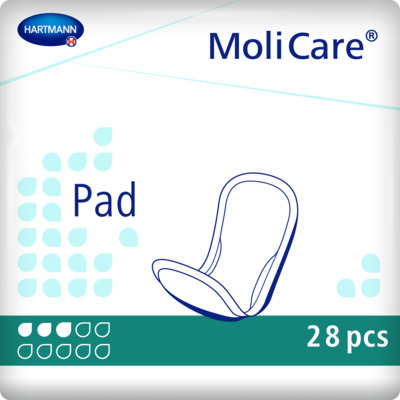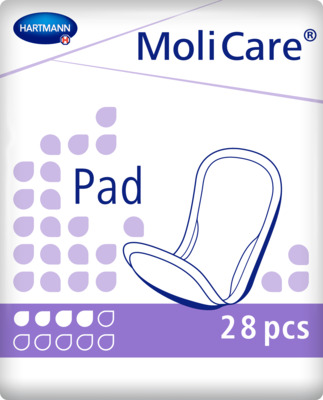Incontinence Advice
Giggle Incontinence in Children and Adults
Giggle incontinence is a topic that is commonly misunderstood. While it is widely associated with children, it can occur in adults, too, to a greater or lesser degree. Giggle incontinence is defined as involuntary urinary leakage while laughing. But can this effect be prevented? And can incontinence products help? In this article, you will find all the answers you need to know about giggle incontinence, including its causes, its impact, and how to effectively manage it for a carefree lifestyle.

Understanding the Causes and Impact of Giggle Incontinence
The precise cause of giggle incontinence, particularly in children, is not fully understood, despite numerous studies. Experts theorise that laughter might trigger unstable contractions in the detrusor muscle, the muscle responsible for bladder control, especially in those susceptible to detrusor instability.
A study conducted in 2002, which examined 109 children with giggle incontinence, shed some light on giggle incontinence. It was observed that 43% of these children also experienced diurnal voiding symptoms, indicating a potential link between urinary control and giggle incontinence.
It has also been theorised that women are more likely to suffer from giggle incontinence than men. A recent article highlights this from a trained professional regarding why women are more likely to wee when they laugh.
Who Is Affected By Giggle Incontinence?
Children with existing conditions such as convulsive disorders or nerve damage appeared to have an increased risk of developing this form of incontinence, which can be managed by using incontinence products such as our stramplepeter pads.
Predominantly observed in children, giggle incontinence commonly begins to manifest between the ages of 5 and 7. The condition is significantly more prevalent in girls, with a higher incidence rate in young girls aged 7 and 14 years. However, the severity and frequency of giggle incontinence vary among individuals. Many find that the condition improves with age, showing fewer episodes during the teenage years, though it can persist into adulthood for some.

Why Is Giggle Incontinence Misdiagnosed?
The real challenge of giggle incontinence lies in its impact on the quality of life, particularly for children. When it starts to interfere with daily activities and social interactions, it becomes a significant concern. Misdiagnosis of this condition is common, as symptoms of daytime urinary incontinence and leakage can be mistakenly attributed to giggle incontinence.
Other potential causes, such as urinary tract infections, constipation, or the consumption of caffeinated drinks, must be considered and ruled out. Instead, consider drinking bladder-friendly drinks and learning about what is the fastest way to get rid of a bladder infection from your GP to lessen incontinence-related issues.
Many people feel embarrassed or uncomfortable about talking about this condition openly, similar to other forms of incontinence or bodily dysfunctions. However, speaking to a medical professional should be your first port of call with any primary concerns you may have about your giggle incontinence. More often than not, there is a solution.
To this end, a thorough evaluation by a GP or urologist is essential. This may involve maintaining a bladder diary to monitor the frequency and volume of urination and to identify any associated symptoms like urgency or incontinence triggered by other activities like sneezing, coughing, or straining.
How Is Giggle Incontinence Treated
Treating giggle incontinence, particularly in children, involves specific, specialised treatment.
A Thorough Incontinence Assessment
This can be carried out to narrow down direct causes and potential concerns. This includes treating constipation, ruling out UTIs, and ensuring proper hydration. Relaxing voiding techniques are also recommended to ensure complete bladder emptying.
Achieving an accurate diagnosis
An accurate diagnosis is crucial to treat giggle incontinence effectively. True giggle incontinence is characterised by a complete or near-complete in response to laughter, without other urinary dysfunctions. Consulting your child’s doctor, or other relevant healthcare professionals, is the optimum way to receive an accurate diagnosis.
Biofeedback Therapy
Biofeedback therapy aims to help you gain control of involuntary impulses in your body. This non-invasive technique can improve control over the pelvic floor muscles, a key factor in managing involuntary urinary leakage when laughing. It focuses on improving muscle tone, allowing children to control their bladder functions better, especially when laughing.
Pharmacotherapy
While biofeedback therapy is preferred for its non-invasive nature, pharmacotherapy (therapy using medication) is an option too. Knowing when to incorporate pharmacotherapy correctly can be effective in certain cases of giggle incontinence. Pharmacotherapy aims to manage bladder contractions and improve urinary control, and needs to be considered only after evaluating potential side effects.

Giggle Incontinence In Adults
Persistent symptoms throughout adulthood will require further investigation into potential underlying causes, such as overactive bladder muscles, vaginal pooling, or dysfunctional voiding. All of these conditions require a specific approach to treat and manage.
To separate giggle incontinence from other forms of the condition, you need to look at the signs and symptoms. Usually, incontinence can be related to pressure on the pelvic floor muscles, also known as stress incontinence, and is usually caused by actions like sneezing, coughing, or physical strain. Stress incontinence typically involves significant leakage, often leading to a full bladder emptying. In this case, knowing how to stop urine leakage when coughing is essential, as this can affect children and adults greatly.
In cases of giggle incontinence, the bladder's detrusor muscle, which is integral to its structure, involuntarily contracts when laughing, leading to unintended urination that is usually only slight that can be managed with light incontinence products.
Another symptom could be frequent bedwetting. The frequency of wetting episodes significantly influences which treatments are offered for giggle incontinence. Medication may not be appropriate for infrequent episodes, and other non-pharmacological strategies can be considered first. Adding incontinence bed protection can also help to protect the bed from possible incontinence leakages.
Treatment options can include pelvic floor strengthening exercises. They should be tailored to each child's or adult’s specific needs and circumstances. Participating in sports with incontinence is still a viable option since sports is good for overall health and well-being. However, some exercises should be preferred over others to help limit the chance of leakage.
We have numerous articles on our blog that explore various causes and treatments for incontinence. In the case of giggle incontinence, lifestyle changes will make less of a difference since it is mostly triggered by laughter. However, if other concerns arise, such as blood in urine, it is important to consult your GP immediately as there may be other underlying concerns, both for children and adults.
Skin Care Products
Explore our skin care products now

Stop Peeing When Laughing
In conclusion, giggle incontinence is one of the easier forms of incontinence to manage with molicare pads, but it can be easily misdiagnosed. While its exact causes remain elusive, treatment options like biofeedback therapy and pharmacotherapy offer effective management for adults and children. Accurate diagnosis, understanding the symptoms, and reassuring the individual about the condition are key to supporting those affected for an easier lifestyle. As children grow, symptoms often improve over time, but if not, greater measures can be implemented to manage the condition in adulthood.

FAQs
Can giggle incontinence be cured?
Giggle incontinence in children often improves or resolves over time, but it may not always be completely cured.
Why can't I hold my pee all of a sudden?
Sudden difficulty holding urine could be due to various factors, including urinary tract infections, muscle weakness, or neurological issues. Consult a healthcare professional for a proper diagnosis.
Why do I keep wetting myself when I laugh?
Laughing can put pressure on the bladder, causing involuntary urine leakage. This is often due to weak pelvic floor muscles, a common issue known as stress urinary incontinence. It could, of course, also be giggle incontinence. It is important to consult a healthcare professional for a correct diagnosis.
How can I help my child with giggle incontinence?
To assist a child with giggle incontinence, consult a GP for guidance. Strategies may include timed bathroom breaks, pelvic floor exercises, and addressing any underlying causes like constipation.
Sources
Chandra, M., Saharia, R., Shi, Q., Hill, V., (2002) Giggle Incontinence in Children: A Manifestation of Detrusor Instability. The Journal of Urology. [online] Available at: https://www.researchgate.net/publication/11067890_Giggle_Incontinence_in_Children_A_Manifestation_of_Detrusor_Instability [accessed 7/12/23]
Eklund, Z., (2023) Nurse explains the simple reason why women sometimes wee when they laugh. The Mirror. [online] Available at: https://www.mirror.co.uk/news/health/nurse-explains-simple-reason-women-31526130 [accessed 7/12/23]

MoliCare® Premium Men Pad 4 Drops
<h2>Comfortable and absorbent</h2> <p>Why MoliCare for men? Hers are some of the key features of the MoliCare® Premium Men Pads from Hartmann:</p> <ul> <li>Discreet and comfortable</li> <li>Fits the male physique</li> <li>3-layer absorbent core</li> <li>Fast-absorbing system</li> <li>Anti-leakage cuffs</li> <li>Odour neutralisers</li> <li>Wide adhesive strip</li> <li>Skin-friendly</li> </ul> <p>With an affordable price and great quality guarantee, you cannot regret choosing MoliCare® Premium Men Pad 4 drops, equipped with anti-leak cuffs, and 14 pieces per bag.</p> <h2>Slim and discreet under clothing</h2> <p>MoliCare® Premium MEN Pads offer reliable support for men dealing with bladder weakness. Whether it's stress incontinence or urge incontinence, these pads for men are designed to provide a discreet and quick solution on the go. Simply place the pad before applying your underwear and secure it with the adhesive strip for worry-free protection. MoliCare® Premium MEN Pads offer full coverage for men facing very light to moderate bladder weakness.</p> <h2>Leakage protection for men</h2> <p>MoliCare® understands that each individual's incontinence needs are unique. That's why our incontinence products, including MoliCare® Premium MEN Pads, are available in different absorbency levels. You can find the perfect fit and protection for your specific requirements.</p> <h2>Reliable and soft on the skin</h2> <p>Our body-shaped absorbent pads are designed to deliver dependable and skin-friendly incontinence protection every day. Experience discreet comfort with the soft, cotton-like materials and the added benefit of an odour neutraliser, ensuring you feel fresh and confident throughout the day.</p> <h2>Fast delivery to your home</h2> <p>At HARTMANN Direct, we ensure a fast delivery service for all our products. Enjoy free delivery on orders over £50, making it convenient and hassle-free to receive the incontinence products you need. Our dedicated customer care team is here to discuss your incontinence product needs and answer any questions you may have. Call us today on 0800 028 9470 to experience the comfort and confidence that MoliCare® Premium MEN Pads can provide.</p>
MoliCare® Premium Lady Pad 2 Drops
<h2>Skin Friendly Pant Liners</h2> <p>For women that experience slight incontinence and bladder weakness, across different age groups, it can be a challenge to find the right bladder weakness product that is easy to apply and wear without the worry of potential leakages. Fortunately, we understand this approach, hence why we are happy to offer our MoliCare® Premium Lady Pad 2 drops, that is skin-friendly, Aloe Vera applied, and comes with 14 liners per bag.</p> <h2>Slim and discreet liners</h2> <p>Whether dealing with stress incontinence or urge incontinence, these panty liners offer a discreet and easy solution on the go. Simply place the pad in your underwear and secure it with the adhesive strip for all-round protection. Available in different absorbency levels, MoliCare® bladder weakness products cater to all levels of bladder weakness, ensuring secure care.</p> <h2>Control Bladder Weakness</h2> <p>Enjoy the benefits of these body-shaped absorbent panty liners, designed for women with bladder weakness. The pads offer discreet, reliable protection with features including odour control and fast absorption.</p> <p>With a wide adhesive strip, you can comfortably fix the pad in your regular underwear, providing secure and comfortable fixation. The pads are skin-friendly, featuring soft, breathable materials, including foam cuffs, and a top sheet treated with Aloe Vera.</p> <p>Keeping your skin healthy is a priority, which is why MoliCare® Premium Lady Pads have a skin-neutral pH value of 5.5 and an antibacterial finish. They are also dermatologically tested, offering peace of mind.</p> <h2>Buy pant liners online</h2> <p>Never worry about running out with our convenient order service and fast delivery direct to your door. Enjoy free shipping on orders over £50.</p> <p>If you need assistance, our professional customer service team is here to support you in choosing the right product. Reach out to us today at 0800 028 9470 and experience the comfort and reliability of MoliCare® Premium Lady Pads.</p>
MoliCare Pad 3 Drops
<h2>Incontinence pads for men and women</h2> <p>Protect yourself against slight bladder weakness with the MoliCare® Pad 3 drops. Suitable for men and women, offering an ideal solution to regain control and live your active life without interruptions. Slimline, discreet, and contoured to fit your body, these incontinence pads ensure a comfortable and barely noticeable feel, providing exceptional dryness and protection for slight incontinence.</p> <p>Crafted with soft, skin-friendly fabric and a polyester backsheet, these incontinence pads ensure you can confidently go about your day, secure against minor leaks. The wide adhesive fixing strip keeps the pad securely in place, while the super absorbent core wicks moisture away from your skin. The elastic anti-leak edging adds an extra layer of reassurance, and odour neutraliser keeps you feeling fresh and confident. With the MoliCare® Pad 3 drops, you no longer need to let slight or occasional incontinence hold you back from enjoying life to the fullest. Simply adhere the pad to your underwear, and you will barely feel the difference.</p> <h2>Price match promise</h2> <p>Experience convenience with our fast delivery service, bringing your chosen products directly to your door. At HARTMANN Direct, we offer a price match promise and free delivery for orders over £50, making sure you receive both quality and value.</p> <p>If you need further assistance, our customer care team is here to help. Give us a call today at 0800 028 9470, and we'll find the perfect incontinence product tailored to your needs. Take charge of your life with the reliable and comfortable protection of MoliCare® Pad 3 drops. Say goodbye to worries and hello to an active and confident lifestyle.</p>
